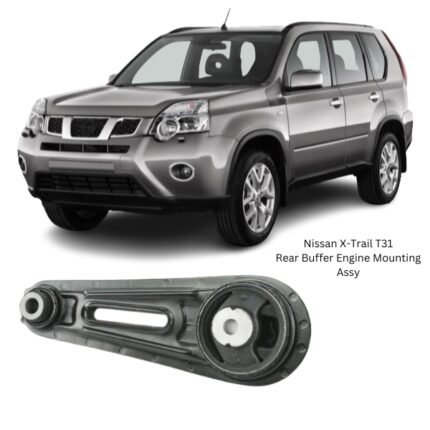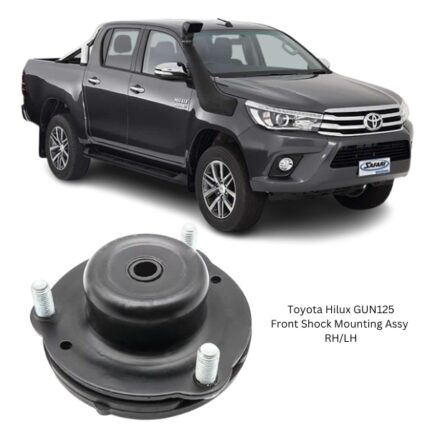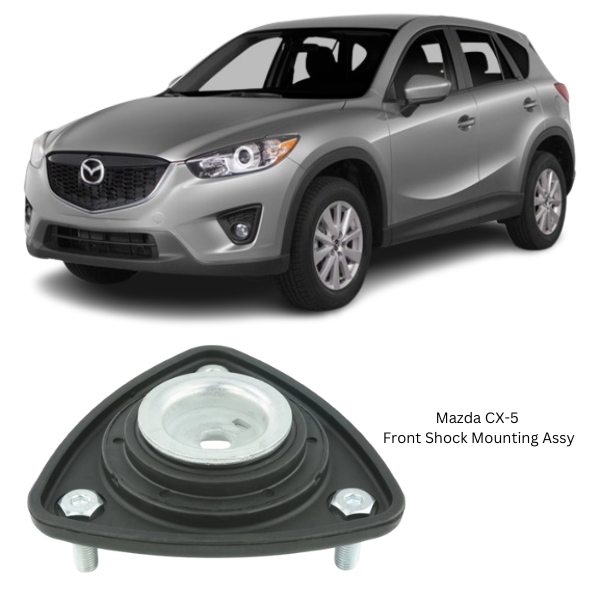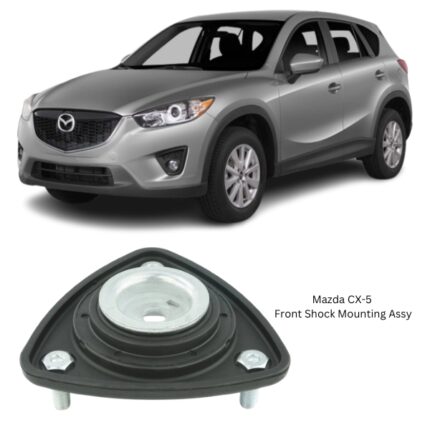Get Mazda CX-5 Front Shock Mounting Assy KD35-34-380 in Kenya
The Front Shock Mounting Assembly, commonly referred to as a strut mount or shock absorber mounting, is a vital component in a vehicle’s front suspension system. This assembly connects the top of the front shock absorber (or strut) to the vehicle’s chassis or strut tower, providing both structural support and a degree of vibration insulation. While often overlooked, the shock mount plays a major role in ride comfort, steering precision, and noise reduction.
More than just a mounting point, modern front shock mounts are engineered to absorb road shocks, reduce noise, and allow controlled movement of the suspension system. They often include bearing components, which enable the front wheels to turn smoothly as part of the steering system.
Key Functions
The Front Shock Mounting Assembly has multiple critical responsibilities:
-
Secure Mounting Point: It forms the upper attachment point for the shock absorber or strut, securing it firmly to the vehicle’s body or frame.
-
Load Transfer: Transfers road-induced forces from the suspension to the chassis, while isolating harsh vibrations and noise.
-
Bearing Support: In strut-type suspension systems (e.g., MacPherson struts), the mount also contains a bearing to support steering movement.
-
NVH Management: Provides vibration damping between metal components to reduce Noise, Vibration, and Harshness (NVH) for better ride quality.
-
Suspension Alignment: Maintains proper suspension geometry, helping preserve accurate wheel alignment and tire wear patterns.
In essence, it is a hybrid component—part structural mount, part bushing, and part bearing—designed to support both vertical motion from road conditions and rotational motion from steering input.
Structure and Design
Depending on the vehicle’s suspension layout and design sophistication, the Front Shock Mounting Assembly can vary in complexity. In MacPherson strut suspensions, it is a more intricate part that includes a bearing plate and rubber insulator. In traditional double-wishbone setups, it may be a simpler bushing-style mount.
Main Components
-
Metal Mounting Plate or Bracket
-
Typically made of stamped or cast steel/aluminum.
-
Bolts directly to the vehicle’s strut tower.
-
Provides the framework for supporting the strut shaft and bearing.
-
-
Rubber or Polyurethane Isolator
-
Acts as a cushion between the metal shock absorber and chassis.
-
Absorbs vibrations, noise, and small road impacts.
-
Designed to flex and compress slightly under load.
-
-
Bearing Assembly (in strut systems)
-
A sealed ball or needle bearing integrated within the mount.
-
Allows the shock or strut to rotate during steering without binding.
-
Crucial for maintaining steering smoothness and feedback.
-
-
Center Sleeve and Mounting Studs
-
Reinforced sleeve through the rubber insulator for bolt passage.
-
Threaded studs or bolts allow secure connection to both strut and chassis.
-
Materials and Durability
The longevity and performance of the front shock mount depend greatly on the materials used:
-
Rubber Isolators: Often made from high-durability, heat- and oil-resistant elastomer compounds. Over time, they may harden or crack, reducing their ability to dampen vibrations.
-
Polyurethane (Performance Option): Used in aftermarket or performance-focused designs. More rigid than rubber, offering better handling at the cost of increased vibration transmission.
-
Bearings: Sealed and lubricated to resist corrosion and prevent contamination by dirt or moisture. Must remain smooth and low-friction for proper steering performance.
-
Steel/Aluminum Mounts: Treated or coated for corrosion resistance and fatigue durability.
Performance and Ride Quality
Though relatively small, the shock mount significantly influences the feel of the suspension system. A worn-out or failing mount can negatively impact:
-
Ride comfort: Resulting in increased road noise, bumps, and harshness.
-
Steering response: Especially in front strut systems, where the bearing is responsible for smooth wheel rotation.
-
Suspension effectiveness: A loose or degraded mount can lead to improper strut function and unpredictable handling.
High-quality mounts help ensure that shocks/struts operate efficiently, tires maintain proper contact with the road, and steering inputs are accurately translated into vehicle movement.
Signs of Wear or Failure
Front shock mounts are subject to constant stress and environmental exposure. As such, they are considered wear items that should be periodically inspected or replaced—especially when installing new shock absorbers or struts.
Common symptoms of a failing front shock mounting assembly include:
-
Clunking or Knocking Noises: Audible over bumps or during turns due to excessive movement or metal-to-metal contact.
-
Increased Steering Effort or Binding: Worn bearings in the mount may cause rough or stiff steering, especially at low speeds.
-
Excessive Vibration: Deteriorated rubber components fail to isolate vibrations, transmitting harshness to the cabin.
-
Poor Handling or Instability: A loose mount can allow the strut to shift, affecting suspension geometry and stability.
-
Uneven Tire Wear: Misalignment caused by mount deformation can lead to irregular tire wear patterns.
-
Visible Damage: Cracks in rubber isolators, rusted metal housings, or play in the bearing can be observed during inspection.
Installation Notes
Replacing the Front Shock Mounting Assy typically requires removal of the shock absorber or strut from the vehicle. The mount is located at the top end of the strut assembly and may need a spring compressor for safe disassembly.
Best Practices:
-
Replace in Pairs: Always replace mounts on both sides to maintain balanced handling.
-
Inspect Related Components: Check coil springs, strut bearings, and bump stops during mount replacement.
-
Follow Torque Specs: Ensure all fasteners are torqued to manufacturer-recommended specifications.
-
Align the Suspension: After installation, perform a wheel alignment to preserve handling and tire life.
OEM vs. Aftermarket Considerations
-
OEM Mounts are designed to match original ride quality and performance standards. Ideal for daily driving and comfort.
-
Aftermarket or Upgraded Mounts may offer increased durability, stiffer materials, or improved steering feel—commonly chosen for performance or off-road applications.
Choosing the right mount depends on driving needs, vehicle usage, and suspension goals.
Benefits of a High-Quality Front Shock Mount
-
Noise Reduction: Smooths out road noise and suspension chatter.
-
Enhanced Comfort: Absorbs shocks and minor bumps, improving overall ride quality.
-
Improved Steering Response: Maintains precise feedback from the front wheels to the steering wheel.
-
Extended Suspension Life: Protects struts and related parts from additional stress.
-
Safe and Stable Driving: Ensures suspension geometry remains consistent even under load or during hard cornering.
Follow us on Facebook for more parts.





Reviews
Clear filtersThere are no reviews yet.